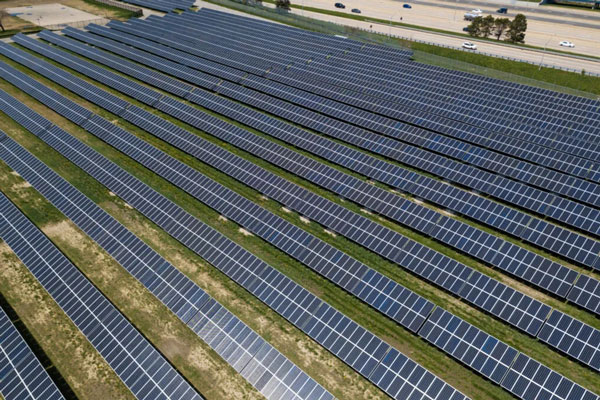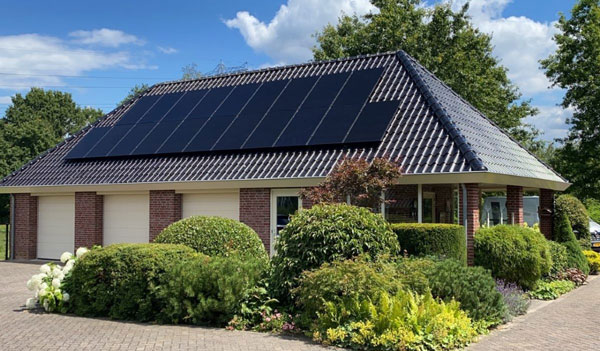Battery Type
Right sizing the capacity and power specifications of solar batteries is essential for maximizing the efficiency and effectiveness of your solar energy system. Capacity and power are related, yet different performance indicators. Capacity, measured in kilowatt hours determines how much electricity your battery can store. Power is measured in kilowatt and reflects the battery’s ability to release electricity and to be charged at a given moment. In this way, capacity indicates how much of the electricity a battery can store and power indicates how much of it a battery can discharge or charge at the same time.
Capacity specifications
Firstly, it is essential to calculate the energy consumption of your household. You should summarise the power of all devices and appliances that will be powered by the solar system. Taking a typical American household that consumes about 30 kWh per day, it could be reasonable to have a battery capacity of around 10-15 kWh to cover the evening and night time. Therefore, all essential things will operate without interruption during the nighttime hours or when it’s cloudy.
Power specifications
Power specifications indicate, how much power the battery can provide at one time. This specification is very relevant to the when several devices in your household demand power simultaneously. For example, if your household is running the air conditioner , which requires up to 3 kW, and fridge, which requires maximum of around 1 kW, and several smaller devices at the same moment, one would need a battery with a power specification of at least 5 kW in order to prevent power shortages to the whole system.

Oversizing and under sizing
When choosing battery size, one should take both consideration of the maximum demand taking place just one day per year and a long term period. Oversizing the battery will be wasting money, while undersizing will result in low energy availability. An effective way is to analyse your energy usage of several months in order to establish the peak demand and then to calculate a long term low demand taking an average from the available data.
Capacity and Power
When choosing what capacity and power of solar batteries to take, it is critical to align these parameters with one’s energy use. This allows your solar system to work with maximum efficiency, covering its energy consumption, and working without failures during its peak output. As for the battery capacity, it should be calculated based on the demands that will be placed on them.
Calculation of Required Capacity
First and foremost, one needs to calculate the required battery capacity, measuring the energy that one’s household might consume in an average day. Supposedly, on a typical day, your household may consume a total of 30 kWh of energy. Then, your batteries need to have enough capacity to store at least this amount, especially when solar input is not available due to time. Generally, 15-20 kWh of capacity is enough for basic energy use from evening to morning.
Power Specifications
Power is another aspect of the battery system, which should also be considered. Power is not the same as capacity – it is the rate at which capacity is consumed or produced. What is important to understand is that power can be used to measure how much energy can be used at one point in time. For instance, in the evening, several pieces of equipment might be functioning at once. Say, in this situation, your average load may total 7 kW. Then, the battery should provide a minimum power output of 7 kW to ensure a smooth supply.
Strategic Sizing
What should also be kept in mind is that precise sizing is geared toward a thought-out approach, which focuses on how one uses energy. For instance, if a person uses a lot of power in the evening, it is preferable to use a battery that would guarantee high power for short periods of time. These quantifications need to be considered from the point of view of a system, which offers a prolonged period of backup.

Compatibility
Selecting a solar battery that is compatible with your solar panels is crucial for the efficiency of energy conversion and prolongation of both the panels’ and battery system’s lives. Multiple factors contribute to this compatibility, some of which include voltage and capacity. A solar battery should also be suitable for solar output.
Voltage match
The first and most important rule of battery selection is that the solar panels’ output voltage should be identical to that fit for the solar battery. For example, one cannot run 24-volt panels with a 12-volt battery. The only exception to this rule is the setup, involving a charge controller, which is designed to manage mismatched panels and batteries. In these cases, the controller transforms the voltage, making it suitable for charging in the process.
Understanding energy capacity match
The battery’s capacity should reflect the energy output of the solar panels as closely as possible. For instance, a battery setup for a system, which generates an average of 5 kWh daily, should have a capacity, allowing to store a similar amount of energy. If the battery capacity is smaller, it will store a smaller portion of the energy generated, and the operation will be inefficient. Should the capacity exceed the charges stored daily, the battery will not fill up completely, which would not be cost-effective. Therefore, the battery’s capacity should be connected to the expected output of the solar panels. It is also important that a battery’s connected amps capacity should exceed what a solar cell generates consistently.
Battery Life and Durability
While choosing a solar battery, its expected lifespan and durability under different operational conditions should be of the primary concern. It can allow making the choice in favor of technology that will remain effective over a long period, which will minimize the need for replacement and maintenance, as well as the associated costs.
Battery Lifespan Estimation
Battery lifespan is typically measured in charge cycles, which represent the number of discharge and recharge operations the equipment can perform before its capacity decreases to 80% of its key parameters. For example, large lithium-ion units, which are a viable high-quality option for this purpose, typically feature from 1,000 to 3,000 charge cycles. An accurate estimation of the lifespan of the battery can allow planning and budgeting for the eventual replacement in the future.
The Effect of Usage Patterns on Durability
In addition, the durability of a solar battery is significantly affected by the manner of its usage. In the case of batteries such as lead-acid ones, repeated deep discharges, which can be a likely occurrence in improper use, significantly decrease the lifespan. At the same time, these effects are less likely to occur in the case of lithium-ion batteries, which are far more capable of recovering from varied levels of discharge. In addition, batteries are most durable when their size meets the users’ expected daily energy needs, as they can wear prematurely in other circumstances. In order to maintain battery performance properly, it should not be discharged beyond 50% of its capacity on a regular basis.
Environmental Factors Affecting Durability
Finally, another type of factors that can significantly affect a solar battery’s lifespan is the environment in which it is used. High temperatures and insufficient ventilation can cause batteries to perform less well than expected and affect their lifespan in all cases. For instance, degradation of multiple battery types accelerates in conditions of 30°C and above, while when it comes to low temperatures, subzero conditions will lead to reduced output and increased internal resistance. As a result, this can cause premature problems. Choosing a battery that will perform well in the local climate is necessary for overall performance.
Maintenance and Care
To keep solar batteries working efficiently and to ensure a long service life, it is necessary to look after them properly. Both routine inspections to ensure that nothing is amiss and routine care guided by the type of battery in your solar energy system will be necessary.
Inspections and Cleaning
All batteries require that the area is kept clean. This means that no dust should accumulate near them. Regardless of which batteries you use, do not allow the terminals to corrode. This simple step can prevent connection problems if need be, clean the terminals with a solution of baking soda and water to remove any buildup of corrosion.
Water Levels
With flooded lead-acid batteries, it is important to maintain the appropriate water levels. Ensure that the cells never go too long without checking, and it is advisable to check on the level every two to three months at most. The water should be distilled to ensure no contamination occurs inside the cells, which would cause the battery to have a reduced lifetime or a reduced capacity. Being that bursting is also a possibility, it is not recommended to overfill the batteries.
Temperature and Environmental Controls
Keeping your batteries in an appropriate environment can significantly extend their useful life. They should be inside in a physical space that is clean, dry and temperature controlled. The lifespan of a battery is severely compromised by either too hot or too cold a temperature. A room that is consistently between 10°C and 25°C is ideal.
Balancing and Reconditioning
Finally, in a system with multiple batteries, which is common in larger solar setups, all batteries should be periodically balanced to ensure the longevity of both batteries. Since neither of them will be overworked, no single battery in the set will fail any earlier than the others. Periodic reconditioning is a must in the case of some nickel-based batteries.

Security and Installation
Choosing and installing solar batteries correctly and safely is as important for their efficient performance as for preventing any hazards related to battery storage. This process always involves detailed planning and acting in accordance with particular safety standards.
Site Assessment for Installation
The first step to pursue when installing solar batteries is to identify the place where they will be situated. For this purpose, assessing the site where batteries will be installed will be necessary to determine the best place for them. The site determinants will include accessibility to batteries in case of any manipulations or maintenance, sufficient ventilation of the batteries, and appropriate protection from the environmental impact. Installing batteries in a cool, dry, and well-ventilated place will reduce the risk of their overheating and extend the lifespan of batteries.
Secure Mounting and Housing
Heavy batteries, such as lead-acid ones, will require secure mounting to cope with their weight and protect from all types of environmental stress, whether physical shocks or vibrations. Additionally, mounting the batteries will require their housing to protect them from moisture and dirt, which both can cause the batteries’ improvement and the corrosion of their different elements and connections. Finally, every battery installation has to comply with the existing local or national building codes and standards, which also apply to the electrical system.
Electrical and Fire Safety
Working with batteries may be dangerous in all cases; thus, it requires special attention to be paid to electric safety. This implies using the appropriate wiring gauge and connections and circuit breakers or fuses, which is enforced by the local or national standards. Since batteries store so much energy, it is also protective to install a fire suppression system or always have fire extinguishers nearby. In both cases, regular checking and measuring will be required to ensure that those systems are always functional.
Professional Installation
The least harmful way to install a solar battery system is always to hire professionals for this task. Their work will guarantee that the installation complies with all safety guidelines and that the system is working right.
Cost-effectiveness
Cost-effectiveness analysis for solar batteries needs to consider more than upfront cost but the long-term savings and benefits. It is known for a fact that a more complete view is given by a more long-range analysis, which involves a study of the return on investment in solar battery technology. There are a few components to be taken into consideration when conducting this analysis.
Initial Investment vs. Long-Term Savings
The current investment in solar batteries is a hefty one, especially when considering more advanced and higher capacity technology, such as lithium-ion of last generation. However, it is not the upfront cost that makes technology more or less cost-effective, but long-term savings. These include lower bills for electricity, the less load on the grid system on peak demand loads, and possible incentives provided by regional-based renewable energy programs.
Lifespan and Maintenance
Whether a solar battery is cost-effective or not is largely dependent on how long it will be operational and how much money maintenance will take. Lead-acid batteries might look more attractive upfront due to their lower cost, but considering their average lifespan and maintenance needs they seem far less attractive compared to lithium-ion counterparts.
Efficiency
Energy wasted is not used and, consequently, not generating money. Efficient use of its capacity and charge optimizes the cost-effectiveness of solar batteries. For example, the battery management system can control the rate of charge or the depth of discharge to extend the life of the battery and maximize its usage and operational efficiency. Furthermore, when energy is stored and not wasted, the return on capacity is financially optimal.
Government Subsidies
Many governments have programs that allow customers to receive tax-refunded incentives or even a direct subsidy. Some programs allow users to sell the excess of the generated power back to the grid in exchange for compensation. For residential neighborhoods, energy stored by solar batteries and sold to the grid does in fact increase subsidies for users who compensate for net generating power.



